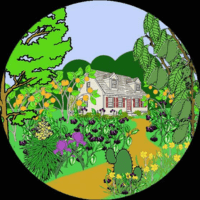Chokeberry (Aronia) Plant Guide — grow, harvest & eat a SUPERFUIT!
Chokeberry health benefits are OFF-THE-CHART. And, it’s a highly versatile shrub — we barely prune them and after three year, DON’T water our Chokeberries!
Aronia, Aronia Berry and Black Chokeberry are other names for the Chokeberry. Aronia melanocarpa is the specific species. Chokeberry is a medically confirmed SUPERFRUIT. The fruit is LOADED with “high antioxidative activity”. Chokeberry has TONS of different polyphenols and flavonoids (stuff that’s good for us). Another study published by NIH says that Chokeberry leaves are a valuable source of bioactive substances!
This is a HEPPY™ plant. They need NO water once established, show NO disease and NO pests, grow compact, and are adaptable to soils. They bloom beautifully in spring and have colorful leaves in fall. And she grows in zones 3 to 8 (basically, across all of America!). Chokeberries are HEPPY!!
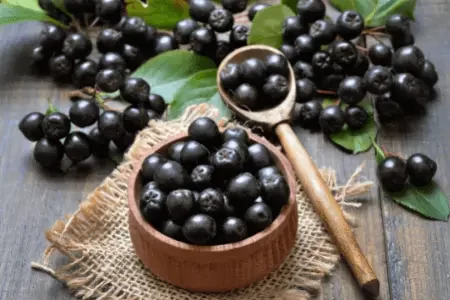
Chokeberry Plant Guide
On this page:
1. Chokeberry Fact Sheet.
2. Types of Chokeberry Plants
3. Chokeberry in landscaping and garden ideas.
4. Eating Chokeberries and its medicinal qualities.
5. Chokeberry health benefits.
6. Commercial viability.
7. Chokeberry Plant Guide for Care and Maintenance.
8. Propagating Chokeberry.
9. Varieties that we grow organically right now!
________________________________________
see our list of 400 edible plants
YouTube channel (please subscribe)
YouTube playlist for CHOKEBERRY
As an Amazon Associate, HEPPY earns from qualifying purchases (paid link).
Black Chokeberry Fact Sheet
common names: Apple berry, Aronia, Aronia Berry, Black Berried Aronia, and Chokeberry.
Zone: 3 to 8
Height: 3 to 6 feet
Native: North America
Bloom Time: May
Bloom Color: White with rosa colored stamen (very attractive)
Fruit Maturity: July – August
Self-fertile: yes
Sun: full sun to part shade
Water: medium (tolerates drought and boggy soil)
Soil: forgiving
Maintenance: low
Growth Rate: medium
Deciduous or evergreen: deciduous
Edible¹: yes (more information is below)]
Medicinal²: yes (discussed below)
Commercial viability: strong (discussed below)]
Family / Genus (species): Rosaceae / Aronia (Aronia melanocarpa)
Remarks: a superfruit; low maintenance; pest/disease free; grows in boggy soil (I read) AND can tolerate drought; a forgiving plant; hedgerow plant; branches hold the fruit well. Deer LOVE this plant and will eat it to death :(. but we have NO issues with rabbit or groundhog (oddly).
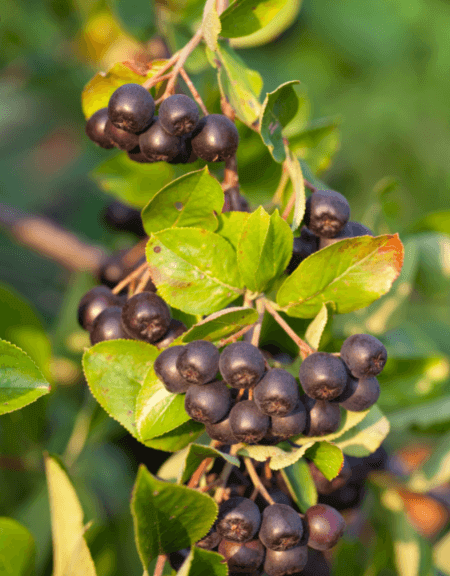
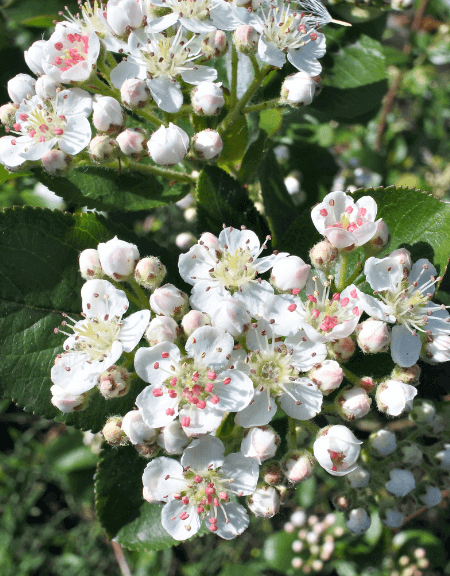
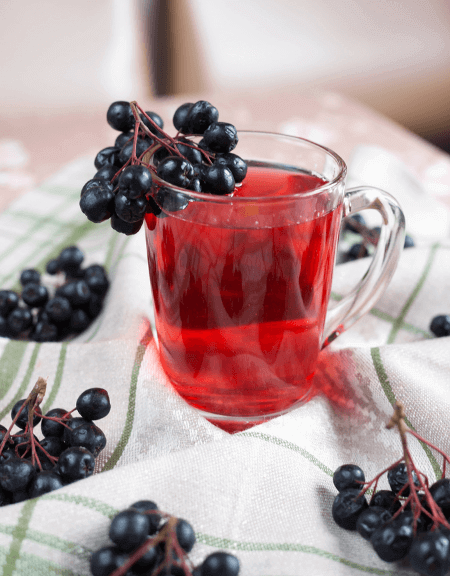

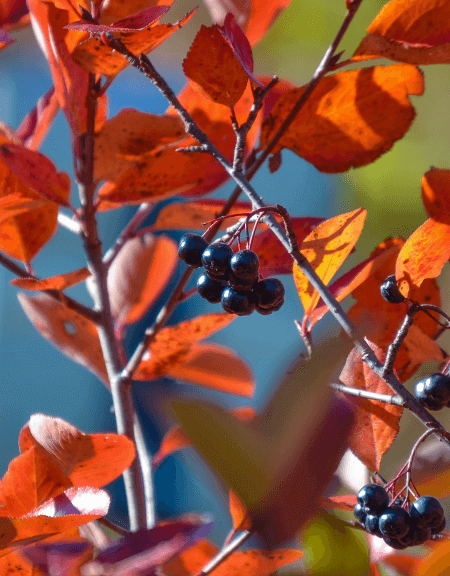
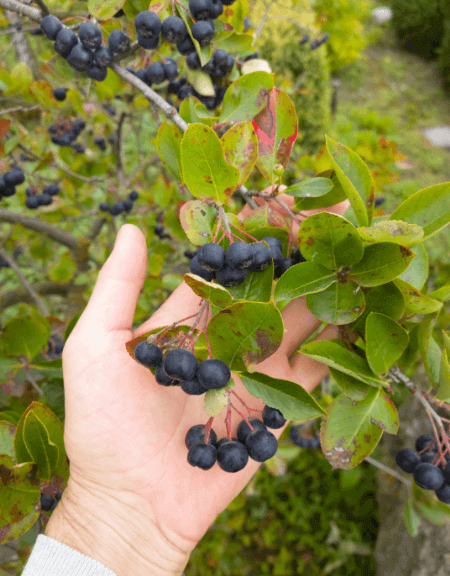
Types of Chokeberry — Black, Red and Purple
all three types are native to North America. all three are self-fertile, grow as multi-stemmed shrubs, and are low-maintenance. all three have showy white flowers in April/May, and leaves provide brilliant Fall colors. finally, they have similar native range across the North America — from Eastern Canada to Georgia, and then West from Minnesota to Louisiana.
distinct differences are the fruit’s color (black, purple or red), and maximum height (ranging from 6 to 12 feet, depending on the species).
Three Types of Chokeberry
Black Chokeberry (Aronia melanocarpa)
commonly called Aronia, this species’ fruit is famous for it’s nutritional qualities. “pom aronia,” “aronia berry” are common product names. Aronia melanocarpa is the proper species name. Pyrus melanocarpa and Photinia melanocarpa are NO longer used (be aware).
the Black Chokeberry is the smallest of the three Chokeberries — growing to 3 to 6 feet.
this plant grows in zone 3 to 8.
this ‘girl’ is a medically confirmed SUPERFRUIT. The fruit is LOADED with antioxidants. NO water once established, NO disease and NO pests, grow compact, and are adaptable to soils. And, they bloom beautifully in spring and have colorful leaves in fall. the webpage below is dedicated to the Black Chokeberry.
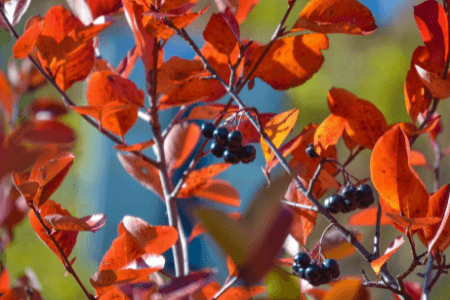
Purple Chokeberry (Aronia prunifolia)
little is written about the Purple Chokeberry. it is commonly referred to as a is a hybrid shrub — a mix between the Black and Red Chokeberries.
another common species name is Photinia floribunda. yes, it’s THAT confusing. HEPPY’s two most trusted sources — USDA PLANTS and the Missouri Botanical Garden — use Aronia x prunifolia.
the Purple Chokeberry is the largest of the three Chokeberries — growing to 8 to 12 feet.
this plant grows in zone 4 to 7.
NIH PubMed research shows that the Purple Chokeberry has antioxidants; however, the Black Chokeberry has the “greatest level of total phenols, antioxidant activity, and individual phenolic acids.”
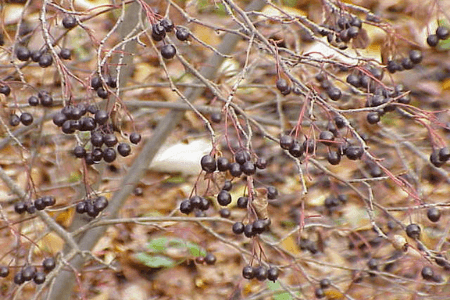
Red Chokeberry (Aronia arbutifolia)
the Red Chokeberry has distinctly red berries and virtually everything else is the same as the Black Chokeberry. Except, for the berries’ taste.
Red Chokeberry fruit are edible1, 2; however, the fruit is not as flavorful as the Black Chokeberry. like the Purple Chokeberry, the fruit is used to make pemmican. Pemmican is a mixture of tallow, dried meat, and dried berries that is used as a nutritious food.
also, Red Chokeberry’s fruit is described as more edible after the first frost. so it’s like kale — yummy :/
the Black Chokeberry is the smallest of the three Chokeberries — growing to 6 to 8 feet.
this plant grows in zone 4 to 9.
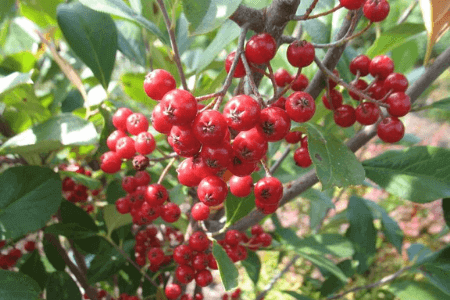
Chokeberry in landscaping and garden ideas
Chokeberry are inexpensive to buy, easy to grow and are an attractive shrub. yet, it’s not commonly grown. they are compact and tolerate partial shade. they fit ANY landscape idea and garden … that deer cannot access (or use protective elements).
Landscape Architecture
in landscape architecture, Chokeberry need little space. they grow compact, and are hardy to -40°F (zone 3). heat and drought tolerant, the Chokeberry also grows in boggy conditions. full sun or part shade.
Chokeberry are used as an ornamental hedge or a single accent plant. it is an attractive plant with glossy dark green leaves and in Fall, show suburb shades of orange (“Fall colors”). they have strong and erect branches. VERY little pruning is needed; they grow as compact shrubs with evenly distributed branching . it fits in any backyard and front yard landscaping design.
Aronia melanocarpa is a superfruit. adding this plant to a landscape architecture shows YOUR consideration beyond aesthetics. be progressive and take credit.
it is an excellent, reliable and low-maintenance fruiting shrub. Chokeberry WILL fit your in landscape architecture.
Garden Ideas
grow Chokeberry for an ornamental effect or for fruit. find a sunny location if you want optimal flowering & fruit.
disease/pest free means no spray or chemicals are needed. water is optional once she’s established ;). however, it also grows in boggy conditions. they tolerate many soils but HEPPY™ grows Chokeberry in rich organic soil (reducing/eliminating need to water).
this is a highly adaptable plant with supreme human health benefit. Chokeberry should be part of ALL garden ideas!

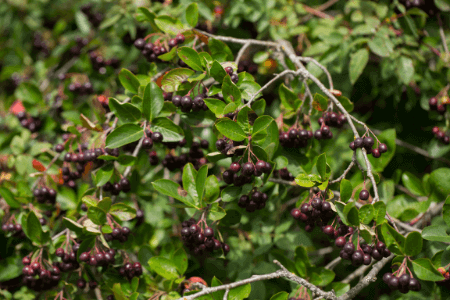
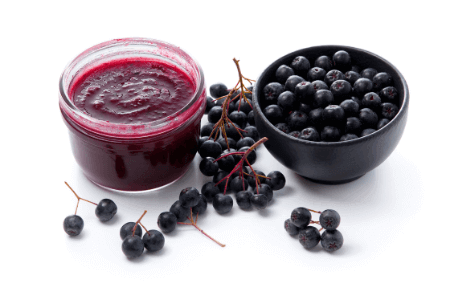
Chokeberry Fruit — How To Enjoy Eating Chokeberry
1, 2 HEPPY cannot take any responsibility for any adverse effects from the use of plants. Always seek advice from a professional before using a plant for food or medicinally. This information is intended for educational purposes only and should not be considered as a recommendation or an endorsement of any particular medical or health treatment.
Edible fruit
Chokeberries are easy to pick, refrigerates and freezes well, and many food products can be made with it. it’s also a superfruit!
pick Aronia melanocarpa fruit ONLY when it’s ‘jet black’ in color. super black. otherwise, unripe fruit is astringent. taste test the fruit — you’ll know if the fruit is unripe ;). picking season is July to August in Maryland.
make jams, preserves, dry the fruit, bake it in cookies or cakes, or make vine! making smoothies is our favorite way to eat Chokeberry / Aronia. the nutritional and medicinal qualities are below.
Recipes
General Aronia Berry Recipes
the American Aronia Berry Association (AABA) posts MANY recipes. the recipes are all ad-free!!! (OMG, ad-free ;). they have recipes for Chokeberry sauce, jam, vinaigrette, !salsa!. and of course, Chokeberry recipes for muffins, bars, cookies, cake, crisps, bread, and cake!
Aronia Berry Smoothie
Make a smoothie that tastes like a strawberry shake BUT with HUGE human health benefits!
Ingredients:
1+ cup of Black Chokeberry; 1 or 2 bananas; 3 dried figs or dates, or Agave syrup to add sweetness; cinnamon, vanilla and/or coconut milk to taste; and cover ur concoction 😉 with milk.
check-out Dr. Maria making her Aronia Berry Smoothie — our FAVORITE recipe!
Aronia Berry Relish
here’s a recipe via my friend, Mary & PBS Iowa: Fried Kasseri Cheese with Fermented Aronia Berry Relish.
Ingredients
2 cups aronia berries
2 tablespoons sauerkraut juice
orange zest and ginger to taste
1/2 tablespoon serrano pepper
1 cup maple syrup
kasseri cheese & salt
Directions
Combine the aronia berries, sauerkraut juice, orange zest, Serrano pepper, maple syrup ginger and salt in a food processer and pulse. Pour the relish into a jar and store at room temperature for 3-5 days, refrigerate after 5 days. Slice the cheese into thick slices, pat the slices dry and then fry until golden brown.
To plate, add crackers, cheese and top with the Aronia relish.
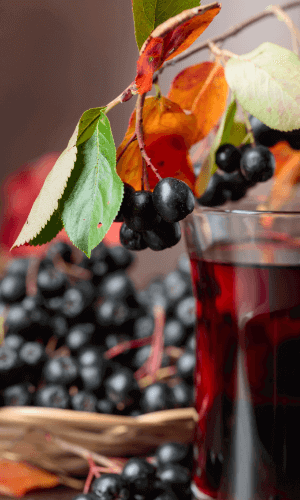
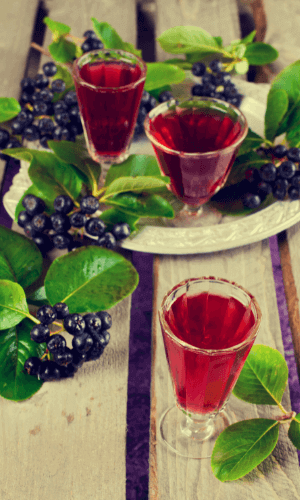

Medicinal Plants and Herbs — medicinal qualities
1, 2 HEPPY cannot take any responsibility for any adverse effects from the use of plants. Always seek advice from a professional before using a plant for food or medicinally. This information is intended for educational purposes only and should not be considered as a recommendation or an endorsement of any particular medical or health treatment.
the health and medicinal qualities of the Black Chokeberry are WELL published.
Chokeberry Aronia melanocarpa has proven to be effective against Diabetes, Hypertension, Atherosclerosis, Achlorhydria (stomach/digestions issue), Avitaminoses (deficiency of one or more essential vitamins), and other diseases! NIH / PubMed, “Antidiabetic Effects of Aronia melanocarpa and Its Other Therapeutic Properties.”
why is the Chokeberry so healthy? the high bioactivity of chokeberries provides some of the richest sources of polyphenols, which include anthocyanins, proanthocyanidins, flavonols, flavanols, proanthocyanidins, and phenolic acids. and, many studies showed high antioxidative activity. various researchers studied apples, bananas, bilberries, blackberry, black currant, elderberries, melons, pears, plums, raspberry, red currant and chokeberry. chokeberry was either the best or on par BUT all of it in ONE fruit (‘best’ or ‘on par’ will all other fruits depends on the “radical scavenging ability” being studied). NIH / PubMed, “Black Chokeberry Aronia melanocarpa, A Qualitative Composition, Phenolic Profile and Antioxidant Potential.”
this was an interesting excerpt, “The content of polyphenols and their exact composition are quite variable and dependent on the particular cultivar, level of fruit ripeness, the growing locality and climatic conditions.” NIH / PubMed, “Fruits of Black Chokeberry Aronia melanocarpa in the Prevention of Chronic Diseases.”


these are excerpts from 6 DIFFERENT PubMed articles
- Aronia melanocarpa fruits are one of the richest plant sources of phenolic substances, mainly anthocyanins–glycosides of cyanidin….Most of the effects of Aronia melanocarpa anthocyanins are due to their high antioxidative activity. PubMed, “Fruits of Black Chokeberry Aronia melanocarpa in the Prevention of Chronic Diseases” (2006).
- by the selection of optimal cultivars and growing conditions, polyphenols of A. melanocarpa represent a good choice for health-promoting activities including immunomodulatory, antibacterial, hepatoprotective, gastroprotective, cardioprotective, antidiabetic, anti-inflammatory and anticancer benefits. PubMed, “Fruits of Black Chokeberry Aronia melanocarpa in the Prevention of Chronic Diseases” (2017).
- A. melanocarpa berry juice and plant extract has displayed evidence as a potent modulator of hyperglycemia-related oxidative stress …[to prevent] cardiovascular disease….Also, people with increased cardiovascular risk (i.e., with abdominal obesity, mild hypercholesterolemia, grade I hypertension) seem to benefit more from the consumption of A. melanocarpa berry juice and extract. PubMed, “Antidiabetic Effects of Aronia melanocarpa and Its Other Therapeutic Properties” (2017).
- Black chokeberry (Aronia melnocarpa) is a source of many bioactive compounds with a wide spectrum of antioxidant and health-promoting properties. PubMed, “Black Chokeberry Aronia Melanocarpa — A Qualitative Composition, Phenolic Profile and Antioxidant Potential” (2019).
- The substances contained in the leaves of berry bushes, particularly polyphenolic compounds, have properties that benefit health….Biological effects of extracts from the leaves of black currant, raspberry, and aronia are associated with their high antioxidant activity, which was confirmed in many in vitro and in vivo analyses. PubMed, “Phenolic Composition, Mineral Content, and Beneficial Bioactivities of Leaf Extracts from Black Currant (Ribes nigrum L.), Raspberry (Rubus idaeus), and Aronia (Aronia melanocarpa)” (2020).
- Chokeberries are rich in phytochemicals that may act as potent anticancer agents. Phytochemicals that are particularly abundant in chokeberries include anthocyanins and phenolic acids. PubMed, “Anticancer Effects of Extracts from Three Different Chokeberry Species ” (2020).
commercial viability of the Chokeberry
a lot of marketing has been done for YOU! businesses & groups on facebook, Aronia Berry Associations, and emerging public knowledge have contributed to marketing this valuable fruit. consequently, Chokeberry’s commercial viability is off-the-chart. and, you can purchase plants for $1 to $3 each (as of 2022).
Farmers' market or cottage food industry
Chokeberry products include juices, powders, capsules, fruit teas, dried berries, freeze dried fruit, and fresh fruit.
the fruit freezes well. so the fresh fruit can be preserved for sale following harvest. processing the fruit into juices, powders, capsules, fruit teas, and dried berries requires levels of processing. it’s up to YOU!
Commercial or private landscaping
large white spring blooms, green foliage, produces superfruit, and spectacular fall colors. the Chokeberry plant is low maintenance, tolerant of heat and drought, adaptable to soils, and requires virtually ZERO pruning. HEPPY™ sees ‘a million’ ways YOU can use Chokeberry in commercial and landscaping applications.
the two issues to note. deer will devour this plant. also, in warmer climates (zone 7, for sure), leaves thin by September. the thick rich spring/summer foliage thins.
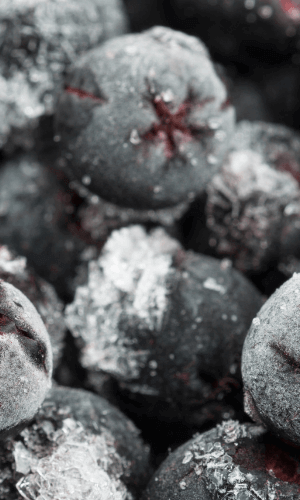
Caring for the Chokeberry: growing, pruning and harvesting
this is a TRULY low-maintenance, easy-to-grow shrub. optimum spacing is 4 to 6 feet between plants; 10 foot spacing if Chokeberry are used for fruit production (USDA). be sure to look for species name, Aronia melanocarpa. the Black Chokeberry has several names (“Aronia” being the most common other name).
Growing Chokeberry
we grow our girls in high organic soil. remember — HEPPY™ LOVES decomposing woodchips and use it extensively. decomposed woodchips are used as a soil amendment and, as a mulch (places around plants on the soil-surface). water retention is superb and our established plants do NOT get watered.
USDA PLANTS writes that, “It is not drought-tolerant.” HEPPY has to respect that. our experience is that we do not have to watch our Chokeberries through hot spells. our girls hold their own. i’m sure it’s the soil.
The best growth and fruit production occurs on low moist but well-drained sites, in full sun (USDA). we space our plants 2 foot and 3 1/2 foot apart. BUT we are an exhibition garden; we recommend 4 to 5 foot spacing for hedgerows, landscaping architecture, and compact garden spaces.
Pruning

pruning Chokeberries is virtually non-existent. dead or diseased branches are rare. Black Chokeberry have very few disease and pest problems, and our plants do not grow fast.
now, in year 4, we will likely prune this winter (2021-2022). our Chokeberries are unusually close together (~2 feet) and they have grown up. air circulation is good. trim branches to encourage growth from the center of the plant outward. also, trim lower, unproductive limbs.
finally, so little pruning is needed that you can prune at any time. winter pruning is optimal; when spring arrives, and the plant begins growing, you want only the desired branches/limbs to get nutrients from the roots.
Harvesting
in this video we we harvest our Chokeberries. it’s 2021 — i read that many farmers had a bumper crop. in if a picture is worth a thousand words then this video is worth a lot more.
check-out the video’s chapter descriptions.
03:39 – identifying ripe fruit (ripe vs unripe)
04:51 – discussing flavor profile
05:18 – how we enjoy eating the Chokeberry SUPERFRUIT
05:28 – Dr. Maria says, Antioxidants – why the Chokeberry is a SUPERFRUIT
06:39 – Aug 8, we wrap-up our picking season
and more, in the video!!!
Propagating Chokeberry: cuttings, division, grafting, layering and seeding
propagating by seed is the most common method (USDA). however, for US residents, why bother? US State Department’s of Forestry / Natural Resources sell Chokeberry plants for $1.50 to $3.00 per 16″ tall plant (bare root).
Chokeberry SEED Propagation
reproduction is primarily by seed. the best germination occurs from seed that has been cleaned. poor germination results from seed that has not been separated from the pulp.
the seeds are small, being slightly more than 1/16 inch long. once the fruit is harvested in the fall, it should be cleaned. for small amounts of fruit, a kitchen blender can be used to macerate the fruit.
separate dried seeds from pulp. Chokeberry seeds have an internal dormancy that can be overcome by being stratified in moist peat for three months between 33°F and 41°F. it is recommended that the seed be sown in September. information provided by, USDA PLANTS, Aronia melanocarpa.
Chokeberry growing at HEPPY™
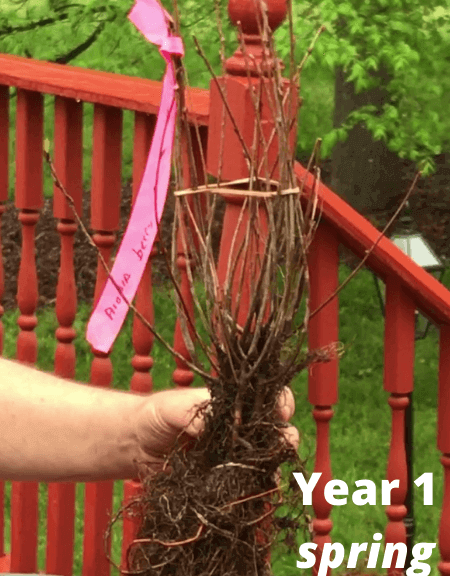
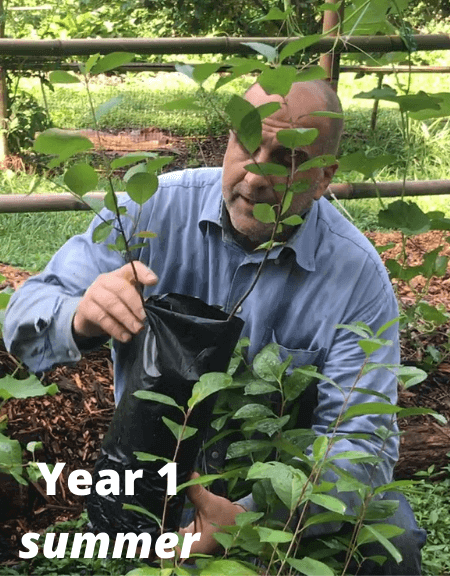

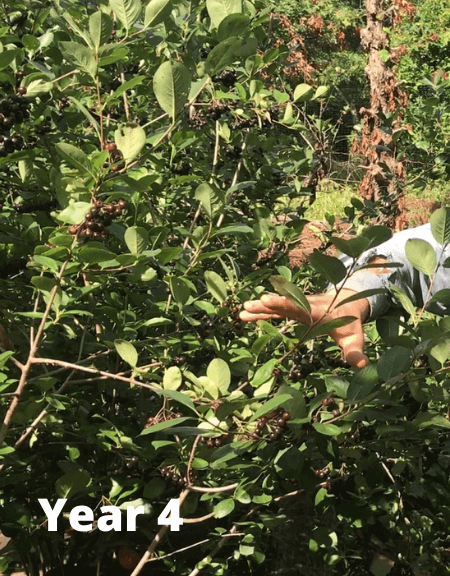
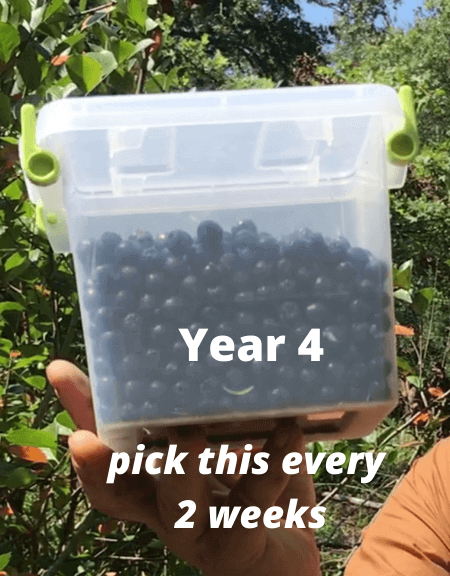
Started with 3 plants
we purchased our first 3 Chokeberries from Edible landscaping. a 1 quart and a 1 gallon plant cost $15 (qt) and $20 (gal). we also purchased 1 Chokeberry in a large, 5 gallon pot for $35. ironically, she very performed poorly.
young plants seem to perform superbly so that’s why our latest collection of Chokeberry were purchased from a State Forestry Nursery.
our spacing is very tight The optimum spacing is 4 to 6 feet between plants. If plants are to be used for fruit production, 10-foot spacing gives more room and light to each plant.
pruning Chokeberries is virtually non-existent. dead or diseased branches are rare. Black Chokeberry have very few disease and pest problems, and our plants do not grow fast.
now, in year 4, we will likely prune this winter (2021-2022). our Chokeberries are unusually close together (~2 feet) and they have grown up. it’s on a raised bed so air circulation is good/adaquate.
MORE Chokeberries planted
we purchased our first 3 Chokeberries from Edible landscaping. a 1 quart and a 1 gallon plant cost $15 (qt) and $20 (gal). we also purchased 1 Chokeberry in a large, 5 gallon pot for $35. ironically, she very performed poorly.
young plants seem to perform superbly so that’s why our latest collection of Chokeberry were purchased from a State Forestry Nursery.
be sure to look for species name, Aronia melanocarpa. the Black Chokeberry has several names (“Aronia” being the most common other name).
our spacing is very tight The optimum spacing is 4 to 6 feet between plants. If plants are to be used for fruit production, 10-foot spacing gives more room and light to each plant.
References
Plants for a Future: Aronia melanocarpa | Aronia prunifolia | Aronia arbutifolia
USDA PLANTS Database: Aronia melanocarpa | Aronia prunifolia | Aronia arbutifolia
Missouri Botanical Garden: Aronia melanocarpa | Aronia prunifolia | Aronia arbutifolia
